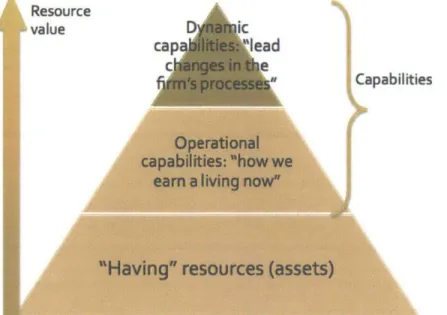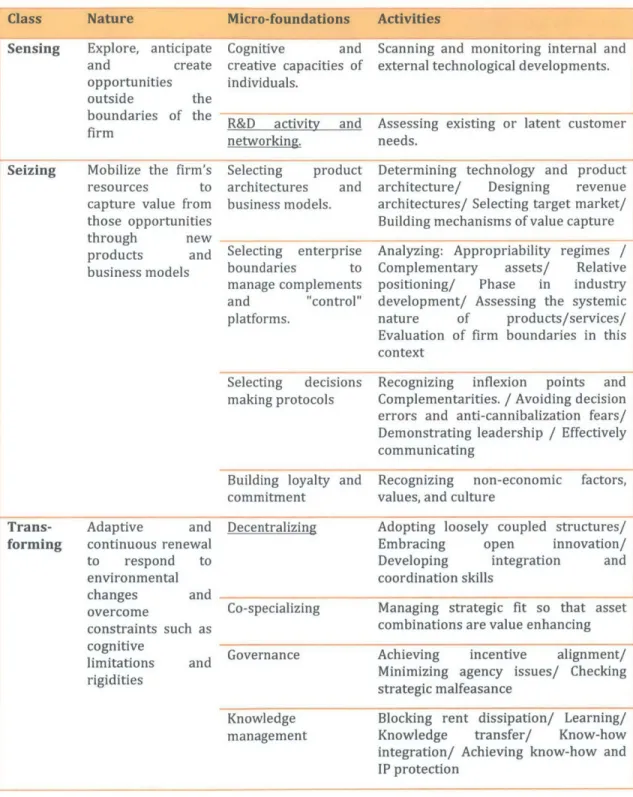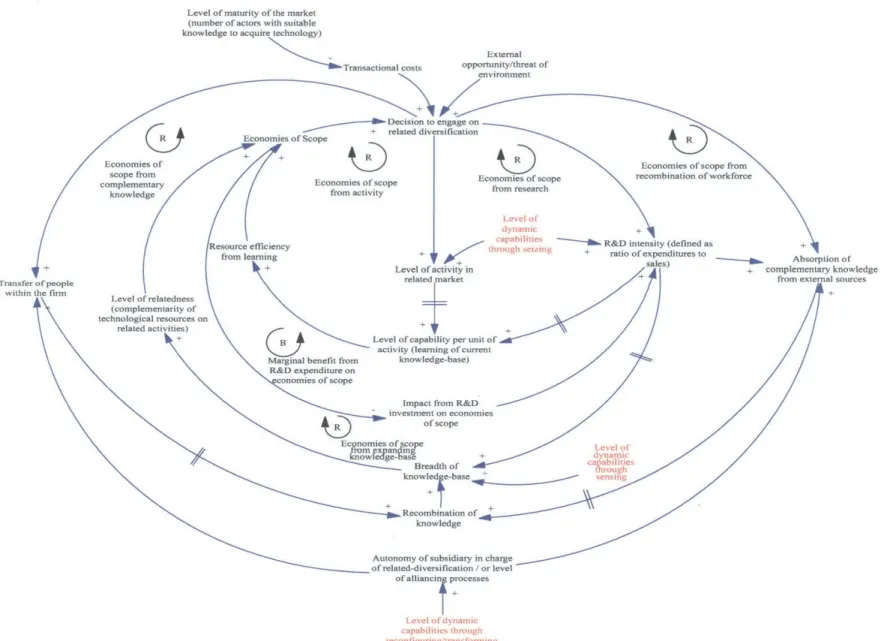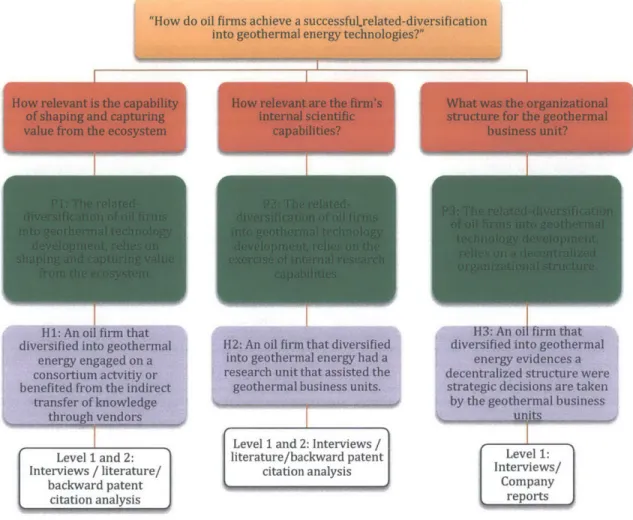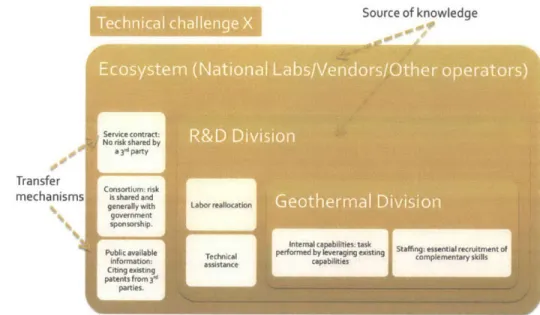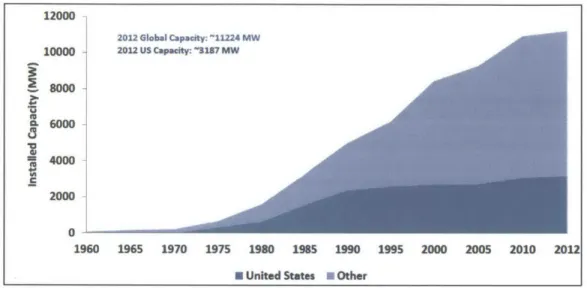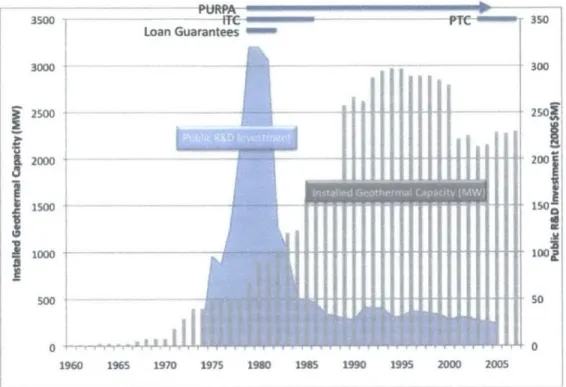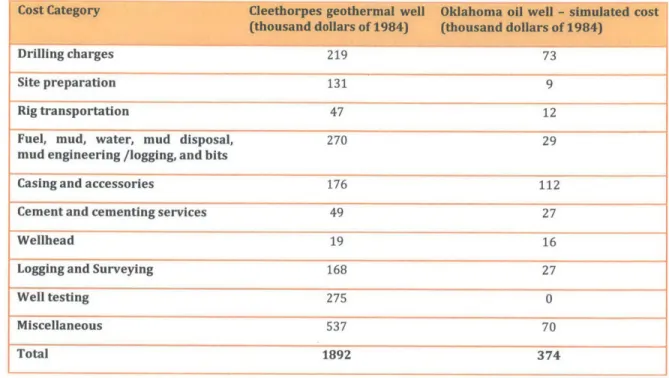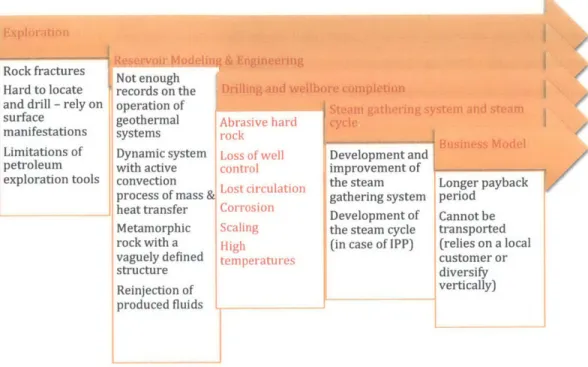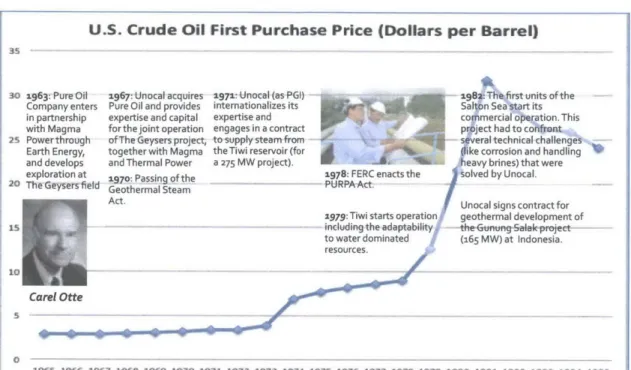Dynamic capabilities in related diversification: the case of geothermal technology development by oil companies
by
Rodrigo Salvador Garcia Palma
Bachelor in Engineering, Civil and Environmental Engineer Pontificia Universidad Cat6lica de Chile, 2002
Submitted to the Engineering Systems Division in Partial Fulfillment of the Requirements for the Degree of
Master in Science in Technology and Policy MASSACHUSES I
at the OF TECHNOLOGY
Massachusetts Institute of Technology
MAY 2 9 2014
June 2014LIBRARIES
0 2014 Rodrigo Garcia Palma. All rights reserved.-The author hereby grants to MIT permission to reproduce and to distribute publicly paper and electronic copies of this thesis document in whole or in part
in any medium now known or hereafter created.
Signature redacted
Sign atu re of A u th or ... . ... ... Technology and Policy Program, Engineering Systems Division
May 8, 2014
Signature redacted
C e rtifie d b y ... ... r... ... Donald R. Lessard Epoch Foundation Professor of International Management MIT Sloan School of Management Thesis Supervisor
Signature redacted
Accepted by ...---..-. . ...
(K
Dava J. NewmanProfessor of Aeronautics and Astronautics and Engineering Systems Director, Technology and Policy Program
Dynamic capabilities in related diversification: the case of geothermal technology development by oil companies
by
Rodrigo Salvador Garcia Palma Submitted to the Engineering Systems Division in Partial Fulfillment of the Requirements for the Degree of
Master in Science in Technology and Policy
Abstract
During the peak oil price period of the 1970s and the first half of the 1980s, 12 major oil firms decided to diversify into the geothermal energy business under the assumption that they could easily leverage their upstream oil capabilities for that purpose. In this thesis I examine how oil firms achieve a successful related-diversification into geothermal energy technologies building on the case studies of Union Oil Company of California and Phillips Petroleum and encompassing 5 geothermal fields and 28 units of analysis that represent the knowledge sources and transfer mechanisms required to overcome the technological and managerial differences between upstream oil and geothermal. The evidence is constructed based on backward patent citation analysis, company reports, literature review and in-depth interviews with the engineers and managers that ran the geothermal business. The two case studies are used to demonstrate that core competencies inherited from upstream oil are necessary but not sufficient to diversify into a related business field. Correspondingly, this research introduces the concept of "dynamic capabilities" to explain how the main enablers of the successful diversification into geothermal energy in the two cases studied, were each firm's dynamic capabilities of: absorbing knowledge from the industrial ecosystem, developing and exploiting internal scientific knowledge, and empowering decentralized business units. Understanding the way that oil firms leveraged their own competencies to diversify into geothermal energy during the oil price crisis can provide important insights into how oil and gas and other extractive industries can meet the sustainability challenges they currently face, and to enhance technology transfer in general. An additional contribution of this thesis is to frame its propositions by integrating concepts from the technology strategy literature into a causal-loop representation of the different factors that influence the evolution of a firm's knowledge stock and its transition into related business fields.
Thesis Supervisor: Donald R. Lessard
Epoch Foundation Professor of International Management MIT Sloan School of Management
Acknowledgments
In the search for a master's degree, I knew I wanted to have the opportunity of learning what drives energy innovation and technology transfer, and I knew that no specific class would provide me an in-depth understanding of such issue. Once at MIT's Technology and Policy Program I found the correct people and the correct references to define this thesis topic and frame an exciting research question. Several individuals have guided and assisted me on this quest, and I want to express my profound appreciation to the most important.
First of all, I am deeply grateful to Professor Donald Lessard, Epoch Foundation Professor of International Management from the MIT's Sloan School of Management, who has believed in my research interest from the very beginning and who has provided me with all the
resources necessary to carry out this project. I appreciate his authentic enthusiasm on this learning process and his wise guidance.
I also want to thank the initial advice provided by Professor Constance Helfat, from the Tuck School of Business of Dartmouth College, who is a key author of the literature referenced on this thesis.
My sincere gratitude and admiration to all of the people I interviewed for the case studies (who are listed under Appendix I: Interviewees), especially to Mr. Steven Pye, former engineer and manager from the Union Oil Company of California, for his generosity to share throughout extended interviews, the details of the Unocal case and his experience in the industry.
I am greatly indebted to the MISTI-Germany program that made possible a productive internship experience at Fraunhofer-Moez in Leipzig, which helped me to develop the background theory of this work and define the research question. In particular, I want to express my personal appreciations to Dr. Thorsten Posselt, Director of Fraunhofer-Moez and Professor of Innovation Management and Innovation Economics at the University of Leipzig, and Daniel Bloemers, Head of Strategic Development and assistant to the Director.
I am also grateful to the scholarship program from the Chilean Government, "Becas Chile", which has funded my two-year masters degree and has made it possible to benefit from the marvelous experience of studying abroad.
Finally, and most important, I want to dedicate this work to my soon-to-be born daughter and my dearest wife Tatiana, who has been patient and caring to support me with unique loyalty and strength during these two years of grad-school experience.
Table of Contents
A BSTRA CT ... 3
A CK N O W LED GM ENTS...5
TA B LE O F CO NTENTS...7
LIST O F FIGU RES...10
LIST O F TA BLES ... 12
I. IN T R O D U CTIO N ... 13
M OTIVATION ... 13
RESEARCH QUESTION ... 15
STRUCTURE ... 16
II. TH EO R ETICA L FRA M EW O R K ... 17
A N INTRODUCTION TO RELATED DIVERSIFICATION... 17
A N INTRODUCTION TO DYNAMIC CAPABILITIES ... 19
A SYSTEMIC APPROACH TO EXPLAIN THE EVOLUTION OF RELATED DIVERSIFICATION...24
III. M ET H O D O LO GY ... 35
OBJECTIVES OF THE RESEARCH... ... 35
PROPOSITIONS AND HYPOTHESES...35
CASE STUDY AS RESEARCH INSTRUMENT... 36
UNITS OF ANALYSIS... 37
Level 1: Each firm's history on geothermal development. ... 38
Level 2: Sources of knowledge and transfer mechanisms required to overcome technical challenges.3...38
SOURCES OF INFORMATION ... 41
Interview s...41
Backw ard patent tracing ... 41
Som e m ethodological considerations ... 43
IV. HISTORICAL CONTEXT OF THE CASE STUDIES AND GOVERNMENT SUPPORT .... 45
THE OIL PRICE CRISIS AND THE DEVELOPMENT OF ALTERNATIVE ENERGY TECHNOLOGIES...45
WORLDWIDE STATUS OF GEOTHERMAL RESOURCE DEVELOPMENT IN THE EARLY 1970S...46
EARLY PUBLIC INVESTMENTS IN GEOTHERMAL TECHNOLOGY AND REGULATION FOR PRIVATE DEVELOPM ENT...48
Investment in research, development and demonstration (RD&D)... 50
Mandating utilities to purchase renewable power at avoided costs through the PURPA ..53
V. AFFINITIES AND DIFFERENCES BETWEEN UPSTREAM OIL OPERATIONS AND GEOTHERMAL ENERGY DEVELOPMENT ... 54
EXPLORATION ... 56
RESERVOIR MODELING & ENGINEERING...57
DRILLING AND W ELLBORE COMPLETION ... 58
A brasive hard rock ... 60
Loss of w ell control ... 61
C o rro sio n ... 6 2
S ca ling ... 6 3
High temperatures ... 64
STEAM GATHERING SYSTEM AND STEAM CYCLE ... 65
B U SIN E SS M O D EL ... 6 6 S U M M AR Y ... 6 6 VI. UNION OIL COM PANY OF CALIFORNIA (UNOCAL)...68
UNOCAL'S DIVERSIFIED ACTIVITIES (1965-2000) ... 68
UNOCAL'S DIVERSIFICATION INTO GEOTHERMAL ENERGY ... 71
H isto ry7...7 1 L ea d ersh ip ... 78
Organizational structure and self-sufficiency of Unocal's Geothermal Division...79
The support from Unocal's Science and Technology Division ... 82
Patenting activity...83
Influence of government-funded research ... 87
Learning by doing at the
fileld
... 89Incremental level of technical sophistication for the Geothermal Division's business units ... 9 1 The Geysers -California...92
Tiwi - The Philippines...96
Imperial Valley - California... 99
DISCUSSION OF TH E CASE ... 105
VII. PHILLIPS PETROLEUM ... 113
PHILLIPS' DIVERSIFIED ACTIVITIES (1965-2000)... 114
PHILLIPS' DIVERSIFICATION INTO GEOTHERMAL ENERGY... 115
H isto ry1...1 1 5 L ea d ersh ip ... 12 0 Organizational structure and self-sufficiency of Phillips' Geothermal Operations...121
The support from Phillips' Research and Development Group ... 125
Patenting activity...126
Sources of learning ... 129
The Roosevelt Hot Springs Field -Utah ... 130
The Desert Peak Field - Nevada ... 136
DISCUSSION OF TH E CASE ... 139
VIII. DISCUSSION . ... ....-...--. .. -. ... 145
IX. CONCLUSIONS AND PROPOSED RESEARCH ... .... ... ... 155
INITIAL INSPIRATION AND APPROACH ... 155
W HAT CAN BE LEARNT FROM THE CASE STUDIES PRESENTED ... 156
FURTHER RESEARCH... 158
REFERENCES.. ... ... ... 161
APPENDIX I: INTERVIEWEES. ... ... ...---... --... 174
APPENDIX III: INTERNATIONAL PATENT CLASSIFICATION CODES FROM THE WORLD INTELLECTUAL PROPERTY ORGANIZATION...178 APPENDIX IV: GEOTHERMAL GLOSSARY...180 APPENDIX V: ACRONYMS...182
List of Figures
FIGURE 1: TWO DIMENSIONS FOR BUSINESS DIVERSIFICATION (TIDD, 2012) ... 18
FIGURE 2 HIERARCHICAL STRUCTURE OF THE RESOURCES AND CAPABILITIES OF A FIRM (BASED ON TIDD 2012)...22
FIGURE 3: SYSTEM OF INTERACTIONS ON THE RELATED DIVERSIFICATION OF A FIRM... 34
FIGURE 4: RESEARCH SUB-QUESTIONS, PROPOSITIONS, HYPOTHESES AND EVIDENCE ... 36
FIGURE 5: SOURCES OF KNOWLEDGE AND TRANSFER MECHANISMS FOR EACH TECHNICAL CHALLENGE ... 40
FIGURE 6: GLOBAL CONTEXT OF U.S. GEOTHERMAL INSTALLED CAPACITY 1960-2012 (GEOTHERMAL ENERGY A SSOCIATION, 2 0 12) ... 4 8 FIGURE 7: PUBLIC R&D INVESTMENTS AND INSTALLED CAPACITY FOR GEOTHERMAL ENERGY TECHNOLOGIES (DORIS ET A L., 2 0 0 9 ) ... 5 1 FIGURE 8: COMMON ACTIVITIES BETWEEN UPSTREAM OIL AND GEOTHERMAL DEVELOPMENT (BASED ON RUEGG & THOMAS, 2011; TORDO, TRACY, & ARFAA, 2011) ... 54
FIGURE 9: MAIN OPERATIONAL CHALLENGES FOR A GEOTHERMAL FIELD IN CONTRAST TO AN OIL FIELD (J. FINGER & BLANKENSHIP, 2010; MIT, 2006; S. PYE, 2013; TEODORIU & FALCONE, 2009). ... 67
FIGURE 10: TRANSITION IN BUSINESS DIVERSIFICATION OF UNOCAL (MOODY'S INVESTORS SERVICE, 1965B, 1970B, 1975B, 1980B, 1985B, 1990B, 1995A, 2000B) ... 70
FIGURE 11: KEY MILESTONES IN THE DEVELOPMENT OF THE GEOTHERMAL DIVISION OF UNOCAL...72
FIGURE 12: TREND OF GEOTHERMAL-RELATED PATENTS, NUMBER OF GEOTHERMAL WELLS, PRICE OF CRUDE OIL (US$/BARREL), AVERAGE PRICE FOR GEOTHERMAL SALES (US$/MWH) AND PUBLIC-FUNDED R&D EXPENDITURES FOR GEOTHERMAL ENERGY (ENERGY INFORMATION AGENCY, 2013; GALLAHER ET AL., 2012; HALL ET AL., 2001; UNOCAL, 1975,1979, 1985,1990, 1995)... 76
FIGURE 13 SKETCHED REPRESENTATION OF THE ORGANIZATIONAL STRUCTURE OF THE GEOTHERMAL ACTIVITIES AT UNOCAL DURING THE EARLY 80S (NEWELL, 2013; OTTE, 2013; S. PYE, 2013; K. WILLIAMSON, 2013)...80
FIGURE 14: DIRECT SOURCES OF UNOCAL'S GEOTHERMAL KNOWLEDGE (HALL ET AL., 2001)...84
FIGURE 15: TREND IN PATENT APPLICATIONS PER YEAR AND PER CLASSIFICATION CODE (HALL ET AL., 2001) ... 85
FIGURE 16: MAIN TECHNICAL CHALLENGES FROM UNOCAL'S DEVELOPMENT INTO GEOTHERMAL ENERGY...92
FIGURE 17: SOURCE OF KNOWLEDGE AND TRANSFER MECHANISMS FOR THE TECHNOLOGICAL DEVELOPMENTS OF THE GEYSERS PROJECT: DRY STEAM SYSTEM ... 107
FIGURE 18: SOURCE OF KNOWLEDGE AND TRANSFER MECHANISMS FOR THE TECHNOLOGICAL DEVELOPMENTS OF THE TIWI PROJECT: WATER DOMINATED FIELD WITH INFILTRATIONS...108
FIGURE 19: SOURCE OF KNOWLEDGE AND TRANSFER MECHANISMS FOR THE TECHNOLOGICAL DEVELOPMENT OF THE IMPERIAL VALLEY/SALTON SEA PROJECTS: LIQUID DOMINATED FIELD, WITH CORROSIVE AND SALINE BRINES ... ... ... ... 109
FIGURE 20: MAIN DYNAMIC CAPABILITIES OF UNOCAL'S RELATED DIVERISFICATION INTO GEOTHERMAL ENERGY T ECH N O LO GIES...1 1 0 FIGURE 21: TRANSITION IN BUSINESS DIVERSIFICATION OF PHILLIPS (MOODY'S INVESTORS SERVICE, 1965A, 1970A, 1975A, 1980A, 1985A, 1990A, 1995B, 2000A) ... 115
FIGURE 22: KEY MILESTONES IN THE DEVELOPMENT OF THE GEOTHERMAL BUSINESS UNITS OF PHILLIPS PETROLEUM ... ... .... ... ... ... ... 116
FIGURE 23: TREND OF GEOTHERMAL-RELATED PATENTS, PRICE OF CRUDE OIL (US$/BARREL), R&D EXPENDITURES FOR PHILLIPS (MMUS$/YEAR) AND R&D EXPENDITURES FOR THE GTP (10KUS$/YEAR) (ENERGY INFORMATION AGENCY, 2013; GALLAHER ET AL., 2012; HALL ET AL., 2001; PHILLIPS PETROLEUM, 1978, 1 9 8 0 , 1 9 8 4 ) ... 1 1 9 FIGURE 24 SKETCHED REPRESENTATION OF THE ORGANIZATIONAL STRUCTURE OF THE GEOTHERMAL ACTIVITIES AT UNOCAL DURING THE EARLY 80S (JOHNSON, 2014; PHILLIPS PETROLEUM, 1980) ... 122
FIGURE 25: DIRECT SOURCES OF PHILLIPS' GEOTHERMAL KNOWLEDGE(HALL ET AL., 2001) ... 127
FIGURE 26: TRENDS IN PATENT APPLICATIONS PER YEAR AND PER CLASSIFICATION CODE (HALL ET AL., 2001)...127
FIGURE 27: SOURCE OF KNOWLEDGE AND TRANSFER MECHANISMS FOR THE TECHNOLOGICAL DEVELOPMENTS OF THE ROOSEVELT H OT SPRINGS PROJECT. ... . ... ... ---.. 140
FIGURE 28: SOURCE OF KNOWLEDGE AND TRANSFER MECHANISMS FOR THE TECHNNOLOGICAL DEVELOPMENTS OF THE
DESERT PEAK PROJECT...141
FIGURE 29 MAIN DYNAMIC CAPABILITIES FOR PHILLIPS' RELATED DIVERSIFICATION INTO GEOTHERMAL ENERGY TECHNOLOGIES...143
List of Tables
TABLE 1: SELECTION OF DEFINITIONS ON DYNAMIC CAPABILITIES ... 21 TABLE 2 CLASS, NATURE AND MICRO-FOUNDATIONS OF DYNAMIC CAPABILITIES. BASED ON (CASTIAUX, 2012B;
T EE CE, 2 0 0 7 A)...2 3 TABLE 3: COMPARISON OF U.K. GEOTHERMAL AND U.S. OIL WELL COSTS (MORTIMER & HARRISON, 1989)...56 TABLE 4: SUMMARY OF THE INFLUENCE FROM GEOTHERMAL CONDITIONS TO THE DRILLING AND WELLBORE
A CT IV IT IES ... 6 0
TABLE 5: INSTALLED CAPACITY THROUGHOUT TIME OF UNOCAL'S GEOTHERMAL BUSINESS UNITS (ASIA TIMES, 2005; UNOCAL, 1969, 1971, 1973, 1977, 1978, 1979, 1989) ... 74
TABLE 6: TOP 5% OF CITED ORGANIZATIONS BY UNOCAL'S GEOTHERMAL RELATED PATENTS (FOR EACH TYPE OF
CLASSIFICATION CODE) (HALL ET AL., 2001)...86 TABLE 7: NUMBER OF CITATIONS TO GOVERNMENT-FUNDED PATENTS BY UNOCAL'S STOCK OF GEOTHERMAL-RELATED
PATENTS (PER CLASSIFICATION CODE) (GOOGLE -USPTO, 2014; HALL ET AL., 2001)... 89 TABLE 8: DIFFERENT APPROACHES TO IMPROVE THE STEAM GATHERING SYSTEM (GAMBILL & BERAQUIT, 1993) ....98 TABLE 9: INSTALLED CAPACITY THROUGOUT TIME OF PHILLIPS' GEOTHERMAL BUSINESS UNITS (W. R. BENOIT, HINER,
& FOREST, 1980; CHIASSON, 2004; PHILLIPS PETROLEUM, 1984; REUTERS, 1985)...118 TABLE 10: TOP 5% OF CITED ORGANIZATIONS BY PHILLIPS' GEOTHERMAL RELATED PATENTS (FOR EACH TYPE OF
CLASSIFICATION CODE) (HALL ET AL., 2001)...128 TABLE 11: SUMMARY OF KNOWLEDGE SOURCES AND TRANSFER MECHANISMS FOR THE DIVERSIFICATION INTO
GEOTHERMAL ENERGY OF UNOCAL AND PHILLIPS...146 TABLE 12: LEGEND OF PREVIOUS CHART, KNOWLEDGE SOURCES AND TRANSFER MECHANISMS...147
TABLE 13: INTERNATIONAL PATENT CODES (IPC) THAT REPRESENT FAMILIES OF GEOTHERMAL PATENT RECORDS
(W ORLD INTELLECTUAL PROPERTY ORGANIZATION, 2014) ... 178 TABLE 14 : A CRO NYM S...18 2
I.
Introduction
Motivation
Oil and gas firms are currently exposed to a new set of challenges1 that demand pushing the boundaries of their businesses and expanding the breadth of their capabilities. Researchers in the field of oil and gas industry strategy have stated that these challenges are the drivers of a "complete paradigm shift" in competitiveness, emphasizing the reduction of greenhouse gas emissions as one of the major pressures (Shuen & Teece, 2014; Teece, Shuen, & Feiler, 2014). Yet, committing resources in the low-carbon energy field could help oil and gas firms discover new sources of competitive advantage while creating positive externalities for the environment (Kolk & Pinkse, 2013). Whatever we can learn from earlier experiences of diversification into low-carbon energy can help guide these technology choices.
On another level, diversification efforts carried out by extractive industries can create positive externalities in terms of value creation and knowledge spillovers. Policymakers from resource-rich countries are taking important steps to expand the boundaries of their economies and transition from industries dependent on natural resources to knowledge-intensive industries. These industries create highly qualified jobs, thus contributing to high value output and reducing dependence on commodity price, thereby increasing global competitiveness (Hvidt, 2013; Kaplinsky, Farooki, Alcorta, & Rodousakis, 2012). Such is the case with countries that have historically relied on the exploitation of oil reserves (e.g. OPEC countries) and currently find low carbon energy technologies an attractive industry to incorporate into their "green growth" strategic plans (OECD, 2011; Popp, 2011).
1 Teece et al. identify the following challenges confronted by oil and gas companies (Teece et al., 2014) : 1) The increasing demand for oil and gas requiring increased production; 2) The
opportunities to exploit unconventional oil and gas resources, by means of new technologies, at new geographies, and using new processes, drives the need for "ubiquitous learning"; 3) The rise of national oil and gas companies and large independents, are increasing the complexity of strategic decisions; 4) The increasingly challenging task of managing the Human Resource Strategy; 5) The permanent need to oversee and adress health, safety, security and environmental risks throughout the business ecosystem; 6) Rising macroeconomic pressure to divert resources to focus on low-carbon sources of energy.
This thesis is inspired by the opportunities for diversification triggered by low-carbon energy innovations from extractive industries, with special attention to the value that these can provide to the industry's knowledge stock. During the 2000-2010 period, U.S.-based oil and gas companies were responsible for 20% of the total U.S. renewable energy investments (Penha, 2010; Switzer, Lovekin, & Finigan, 2013). Part of that effort emerged from innovative activities based on these companies' existing capabilities (which from now on we will call "related-diversification2"). However, as early as the 1973 oil price crisis, oil firms also have been important knowledge contributors to the development of new energy technologies (C. E. Helfat, 1997; Teece, 1980).
One of the most interesting examples of diversification into alternative energy technologies (and the one that has been most studied) is that of the petroleum industry during the oil price crisis period (C. E. Helfat, 1997; Teece, 1980). The "oil price crisis" (named after the period encompassing two major oil price shocks in 1973 and 1978) spurred the diversification of many U.S. oil firms into alternative energy technologies, which increased the annual percent change of energy R&D intensity3 by 6.3 on average between 1976 and
1981 (C. E. Helfat, 1997), and subsequently made available several innovations that expanded the energy technology portfolio at a pace that had not been seen before. A new wave of developments in alternative energy technologies began in this period, at least in part as the result of U.S. government sponsorship through policies like the Energy Security Act and several technology-specific regulations. However, the main driver for diversification emerged from the oil companies themselves, which considered these investments (e.g. synthetic fuels, solar, geothermal, coal gasification and nuclear) strategic opportunities4.
2 This concept will be formally explained in Chapter II.
3 R&D expenditures divided by firm sales.
4 Some of the different ways that oil firms can approach the low-carbon energy technology market (which are defined later in Chapter II as bases of diversification) are, among others (Switzer et al., 2013): 1) Within the fence opportunities: Replacement of conventional fossil fuels for core or support services in operations; 2) Standalone low carbon energy businesses: Establishment of for-profit low-carbon technology production project development & deployment or support services; 3) Venture funds: Strategic investment in external businesses developing low-carbon energy
technologies, projects and companies; 4) R&D support: Support for pre-commercial science, technology and data gap closure; 5) Public policy advocacy: Government relations and other
communications to reduce barriers and enable low carbon energy growth; 6) Leveraging core
competencies: Development of for-profit businesses in areas where O&G competencies are readily translated to the low-carbon energy sector. This is renamed "related diversification" throughout this
The first step in the research was to screen related-diversification cases from extractive industries into low-carbon energy technologies by number of cases. From all the cases collected, diversification from oil into geothermal represented the largest number of occurrences among different firms and also the oldest. Hence, I chose geothermal as the most suitable basis for making comparisons among different contexts and for testing propositions and hypotheses (Yin, 2009).
This thesis identifies the connections (or relatedness) between upstream oil operations and the development of geothermal energy technology, as well as the knowledge transfer mechanisms that enabled such diversification. The way that oil firms leveraged their own competencies to diversify into geothermal energy during the oil price crisis period can provide meaningful insights for today's green growth and competitiveness challenges, even considering the significant contextual differences in commodity prices or industry structure.
During the peak oil price period, some oil firms decided to diversify into the geothermal energy business under the assumption that they could effortlessly leverage their upstream oil capabilities for that purpose. I find that these operational capabilities were not enough to successfully diversify, and that firms also needed to exercise a set of critical "dynamic capabilities" (which are defined in Chapter II).
Research question
I define the research question for this thesis as: "How do oil firms achieve successful
related-diversification into geothermal energy technologies?"
It is important to distinguish this question from other inquiries that imply different methodological approaches. One such inquiry is "Why does an oil firm engage in a related-diversification process into geothermal energy technologies?" This query is not central to this research, yet it is embedded in the overall context of study. As I will show in Chapter IV, the main incentive for an oil firm to invest in geothermal energy technologies had more to
do with exogenous factors such as oil price even if the firm's internal capabilities were readily available to support growth into new technology markets. The chosen research question focuses on the mechanisms of the transfer of knowledge between the oil industry and the then-nascent geothermal industry.
Structure
This thesis is organized into nine chapters: It starts with Chapter II, which includes an in-depth review of firm strategy and firm diversification theory, with the objective of defining related diversification and also introducing the concept of dynamic capabilities and their importance for leveraging the existing capabilities within a firm. In Chapter II, I also propose a causal-loop representation of the different factors that influence the evolution of a firm's knowledge stock, and its implications for related diversification. Chapter III explains the research methodology for this thesis, stating the propositions and hypothesis to be tested, so as to answer the research question posted. Chapter IV includes an overview of the historical context of the oil crisis period to explain the drivers that induced oil firms to develop new energy technologies and the role of government support. Chapter V provides a technical assessment of the challenges of diversifying from upstream oil operations to geothermal development. Chapter VI and Chapter VII include the complete case of related-diversification into geothermal energy for Unocal and Phillips Petroleum, respectively. Chapter VIII builds on the evidence provided by the case studies to analyze and test the validity of hypotheses presented in Chapter III, to reinforce the findings and improve the coherence of the theoretical propositions. Finally, Chapter IX consolidates the results of this thesis, extends the discussion of the legitimacy of results to a wider range of contexts (beyond the oil price crisis time frame and into other extractive industries) and proposes new topics for continuing research on this subject.
11.
Theoretical framework
The first objective of this chapter is to explain how firms leverage their capabilities to enter a new business field, and to relate this to the definition of related diversification. The second aim is to introduce the concept of dynamic capabilities, one of the most influential approaches to explain a firm's strategic behavior. The third purpose of this chapter is to build a comprehensive system to explain the inherent factors and dynamic capabilities that influence the evolution of a firm's knowledge stock, and its implications for related diversification.
An introduction to related diversification
The traditional view of corporate diversification has explained entrance into a new business field as being based on the use of existing physical assets and tangible resources. This approach ignores intangible and internal resources, such as competencies or organizational routines, which are a source of uniqueness and competitive advantage (Chiesa & Manzini, 1997). This section presents a number of studies that emphasize the importance of these intangible resources in achieving business diversification (Doving & Gooderham, 2008).
The boundaries of corporate diversification can be framed based on two dimensions: the supply component, such as the internal competencies5, assets or organizational routines available to the firm, and the demand component, represented by the external market (the products or services created from) for such resources. The chart in Figure 1 illustrates the different combinations that outline the boundaries of the firm, as a function of the competencies and the market it relies on (Penrose, 1996; Tidd, 2012). For example, if a company develops new competencies to sustain its current market position, this will result in market-related diversification (top left-hand side of the chart). To illustrate, consider the case of a conventional car manufacturing company that increases the boundary of its products and services by offering electric vehicles. The firm will be offering a new product to the same market, by developing new competencies. Instead, if a firm uses its existing skills (or similar competencies) to enter a new market (different product/service or
s Competencies are defined as the properties of the coordinating and learning routines of organizations (Dosi & Teece, 1998).
geography), it will be engaging in a competency-related diversification (bottom right-hand side). An example of such diversification is the same car manufacturing company using its capabilities in electronics and engine development to enter the aircraft market. We also have the scenario when the firm uses its existing competencies to enter a new market that is very similar to the one it has already mastered, with limited organizational implications to the firm, and thus no resultant diversification (bottom left-hand side). To represent this, think of the car company opening a new manufacturing plant in a neighboring country with similar market conditions, essentially replicating what it already does. Finally, we have the case when the diversification happens because of non-technological drivers like market power, brand, reputational assets, network of the firm, political power or entrepreneurship aspects of corporate management, which has been termed unrelated-diversification (top right-hand side) (Neffke & Henning, 2013; Tidd, 2012).
Figure 1: Two dimensions for business diversification (Tidd, 2012) 41 Market- Unrelated CL related diversification 4- diversification CL -
~Diversification
-esel Similar Different Market/DemandIn discussing diversification, it is important to distinguish the concepts of relatedness and basis of diversification. The basis of diversification corresponds to the path chosen for driving the firm's diversification forward, which can, for example, be resource-based, technology-based (Tidd, 2012) or even based on the existing organizational routines within the firm (Pavitt, 1998). Figure 1 simplifies the basis of diversification on two dimensions: diversification driven by the market or the firm's competencies. Relatedness is the distance-on the basis of diversification chosen-between the core business and the diversification target. Relatedness is defined as the commonalities and connections among different businesses, like a common skill, resource, market or purpose (Doving & Gooderham, 2008). For example, the car manufacturer diversifying into aircraft manufacturing would have the knowledge the firm wants to leverage as the basis of
diversification, while the relatedness would then be established by the overlap between both industries in terms of skills and disciplines. In contrast, the conventional car manufacturer diversifying into electric vehicles would select the passenger car industry as its basis of diversification, so the relatedness would be defined as the differences in attributes between the conventional-car demand and the electric-vehicle demand.
This thesis will emphasize and study related diversification, given that this type of diversification is recognized as a relevant source of value creation and performance growth (Miller, 2006; Teece, Pisano, & Shuen, 1997). Moreover, this thesis will focus on competency-related diversification (knowledge as the basis of diversification), given that firms are more likely to diversify into industries that have ties to the firms' core activities in terms of competency-relatedness (Neffke & Henning, 2013). Nevertheless, it should be recognized that companies concurrently integrate and leverage related and unrelated-resources for diversification, so there is seldom a pure competency-related diversification or a pure unrelated-diversification (Tidd, 2012). From now on, competency-relatedness will be termed "related diversification."
An introduction to dynamic capabilities
The dynamic capabilities view, one of the most recent and leading perspectives on corporate strategy (Teece et al., 1997), enables identification of the core underlying dynamics of diversification (Doving & Gooderham, 2008). In From Knowledge Management
to Strategic Competence, Sussex professor Joe Tidd presents a consolidated definition for the
term "resources": "stocks of available factors that are owned, controlled, or accessed on a
preferential basis by thefirm" (Tidd, 2012). Tidd also proposes a hierarchical structure for
the resource base of the firm, classifying resources into increasing levels of sophistication or added value:
I. "Having" resources: These resources correspond to the assets of a firm that can be traded in a market so they are not exclusive to the firm and are not firm-specific. Some of these resources can be tangible (such as equipment, buildings, location or low-skilled workforce) or less tangible (like patents, databases or brand). "Having"
resources are generally considered exogenous to the firm. If we use a cooking analogy, these would be the ingredients of a recipe (Lessard & Singh, 2014).
II. "Doing" resources or operational capabilities: These are skill-based intangible resources which do not have a specific market to be traded on, and that demonstrate the firm's potential for performing an activity "on an on-going basis
using more or less the same techniques on the same scale to support existing products
for the same customer population" (Stadler, Helfat, & Verona, 2013). Operational
capabilities are similar to best practices that start in one or two companies and spread to the entire industry (Kleiner, 2013). Examples of these are product development, technology development or marketing. "Doing" resources or operational capabilities are generally considered endogenous to the firm. Continuing the cooking analogy, these operational capabilities are the skills needed to follow a cooking recipe. Core capabilities are the combination of some of these operational capabilities. If a firm places too much emphasis on exercising the core capabilities, it may become rigid and hinder innovation (Leonard-Barton 1993). III. "Dynamic Capabilities": The dynamic capabilities view states that a firm's
competitive advantage lies in distinctive organizational processes, which are shaped by the firm's assets and the evolutionary path the firm has adopted or inherited; these capabilities are continuously and timely adapted to respond to changes in the market (Teece et al. 1997, Tidd 2012). A selected group of definitions of dynamic capabilities are consolidated in Table 1. Dynamic capabilities are what makes a firm distinct from others by sustaining competitive advantage based on a unique combination of resources (Dosi & Teece, 1998; Teece et al., 1997; Tidd, 2012). These are not meant to involve the production of goods or provide services; instead, their task is to continuously improve the execution of an activity by activating practices that continuously reconfigure existing operational capabilities, thus altering the scale and scope of resources of the firm in an effort to influence the firm's external ecosystem6 (C. E. Helfat & Peteraf, 2003; Stadler et al., 2013; Zollo & Winter, 2002). As Berkeley professor David Teece points out, dynamic capabilities "allow an
6 There are several definitions and terms on the literature related with the concept of ecosystems
(national systems of innovation, regional systems of innovations, clusters and ecosystems). All of these share the claim that firm-level innovation depends on the on the "the technological
environment in which a firm innovates", which is determined by the supply of skilled workeers, universities, financial institutions , the legal system, the supply base, the domestic market and the presence of other firms in the same or related industries (Teece, 2010).
organization not only to do things right but also do the right things" (Shuen & Teece, 2014). Some examples of dynamic capabilities are creating and managing cross-functional R&D teams, quality control routines and technology transfer (Eisenhardt & Martin, 2000). Consistent with the cooking analogy, dynamic capabilities are the skills required to create new recipes.
Table 1: Selection of definitions on dynamic capabilities
Reference Definition
(C. E. Helfat et "The capacity of an organization to purposefully create,
al., 2007) extend, or modify its resource base"
(Eisenhardt & "The organizational and strategic routines by which firms
Martin, 2000) achieve new resource configurations as markets emerge, collide, split, evolve and die"
(Teece et al., "The firm's ability to integrate, build, and reconfigure internal
1997) and external competences to address rapidly changing environments"
(Tidd, 2012) "Firm-specific and skill-based intangible resources that make the organization "continuously recognize, integrate, and leverage resources and connect them to the changing environment in order to create value"
(Zollo
& Winter, "A learned and stable pattern of collective activity through 2002) which the organization systematically generates and modifiesits operating routines in pursuit of improved effectiveness"
As can be seen in Figure 2, the concept of "dynamic capabilities" has the highest level of sophistication or resource value, followed by the "doing" resources, and then the "having" resources, which have the least value in the hierarchical structure. This hierarchy favors "dynamic capabilities," given that it enables a dynamic learning process (Teece et al., 1997) for creating new distinctive resources.
Figure 2 Hierarchical structure of the resources and capabilities of a firm (based on Tidd 2012) Resource value
cap
D Ic cap I ea d Capabilities capabitis we"Having
rusoutcs(ses
The concept of dynamic capabilities is relatively new; therefore, there is limited consensus with respect to its definition or even its operational meaning. Still, this is the most appropriate approach to understand the role of resources as a driver of a firm's strategy (Teece, 2010; Tidd, 2012). To better understand the underlying rationale of dynamic capabilities and arrive at a more concrete definition, we need to refer to the operational terms that represent dynamic capabilities. Teece and other authors established these operational terms and termed them micro-foundations (Castiaux, 2012a; Eisenhardt & Martin, 2000; C. Helfat & Eisenhardt, 2004; Kleiner, 2013; Teece, 2007b). These are managerial activities classified into three main groups or classes: sensing, seizing, and transforming. The different types of micro-foundations and their nature are explained in Table 2. The column "Activities" provides examples of the operational terms of dynamic capabilities.
Table 2 Class, nature and micro-foundations of dynamic capabilities. Based on (Castiaux, 2012b; Teece, 2007a)
Class Nature
Sensing Explore, anticipate
and create
opportunities outside the boundaries of the
firm
Seizing Mobilize the firm's resources to capture value from those opportunities through new products and business models Cognitive and creative capacities of individuals.
R&D activity and networking. Selecting product architectures and business models. Selecting enterprise boundaries to manage complements and "control" platforms. Selecting decisions making protocols Building loyalty commitment Adaptive and Decentralizing continuous renewal to respond to environmental changes and -- -overcome Co-specializing constraints such as cognitive G n
limitations and Governance rigidities
and
Knowledge management
Scanning and monitoring internal and external technological developments.
Assessing existing or latent customer needs.
Determining technology and product architecture/ Designing revenue architectures/ Selecting target market/
Building mechanisms of value capture Analyzing: Appropriability regimes /
Complementary assets/ Relative positioning/ Phase in industry development/ Assessing the systemic nature of products/services/
Evaluation of firm boundaries in this context
Recognizing inflexion points and Complementarities. / Avoiding decision errors and anti-cannibalization fears/ Demonstrating leadership / Effectively communicating
Recognizing non-economic factors, values, and culture
Adopting loosely coupled structures/ Embracing open innovation/ Developing integration and coordination skills
Managing strategic fit so that asset combinations are value enhancing Achieving incentive alignment/
Minimizing agency issues/ Checking strategic malfeasance
Blocking rent dissipation/ Learning/ Knowledge transfer/ Know-how integration/ Achieving know-how and
IP protection
There are two microfoundations (or terms to represent the dynamic capabilities) from Table 2 that have been underlined. These represent three key dynamic capabilities that will be the focus of this research:
1. Shaping and capturing value from the ecosystem
2. Developing and exploiting internal scientific capabilities
3. Empowering decentralized units
The following section builds on the academic literature of strategy and management to propose these three dynamic capabilities as enablers for the diversification of oil firms into a related business field, and presents a systemic approach to explain how the firm becomes a dynamic repository of knowledge that can reach new markets.
A systemic approach to explain the evolution of related diversification.
The reader might ask what goes on inside a firm when it leverages existing capabilities and what are the drivers that shape the integration of capabilities and resources to engage into a new market. To answer this question, we need to analyze the system of interactions among resources and capabilities inside the firm (so we can unveil the path dependences) and the influences from external sources of knowledge. Figure 3 (at the end of this chapter) represents the causal loop diagram of this system that will be explained throughout the rest of this section. The purpose of Figure 3 is to sketch the interactions among the firm's resources that drive a related diversification and to show how the organizations become an integrator and repository of knowledge. Figure 3 consolidates different academic references and will not be used for modeling or forecasting. Therefore, it is a simplified version of the dynamic system, and as such does not include an accurate dimensioning of units.
Special attention has been given to the firm's dynamic capabilities and their influence on the system's underlying drivers for diversification (Doving & Gooderham, 2008). All of the different levels of resources and capabilities shown in Figure 2 are relevant technological resources for a competency-related diversification or, as we will call it from now on, a "related-diversification." Still, dynamic capabilities are the most relevant to sensing
opportunities to leverage and "stretch" existing resources and competences into new pathways and integrate and reconfigure such assets and capabilities to create new knowledge. The dynamic capabilities framework claims that a related-diversification can be a viable choice for learning and improving in a new market (Teece et al., 1997; Tidd, 2012); it also claims that dynamic capabilities "determine the evolution of the intersectoral boundaries of the firm (scope of horizontal diversification and vertical integration)" (Dosi & Teece, 1998). Therefore, the stronger the dynamic capabilities of a company, the more prepared it will be for related diversification.
Taking advantage of a firm's relative strengths should pay off by increasing the scale of applicability for their knowledge base into different sectors (Chiesa & Manzini, 1997; de Oliveira & Roa Rubiano, 2011; Prahalad & Hamel, 1990). This notion has been called economies of scope. Economies of scope are present when the cost of producing different outputs (Y1 and Y2 below) together with common resources is less than the sum of the costs of producing each output separately (C. Helfat & Eisenhardt, 2004; Teece, 1980), as long as the resources are not fully used in current operations (Penrose, 1996). Equation 1
explains the rationale behind economies of scope.
Equation 1: Economies of scope for two products
C(Y1, Y2) < C(Y1, 0) + C(0, Y2)
where:
C: Cost production function
Y1: Output of product 1
Y2: Output of product 2
The economies of scope determine the relative importance of a particular type of relatedness during the development of a diversification strategy. This means that the closer a new product is to the previous business of a firm (relatedness), the less expensive it will be to enter this new business (better economies of scope) (Alonso-Borrego & Forcadell, 2010; Neffke & Henning, 2013). Economies of scope reflect the firm's relative position in terms of complementary assets and resources (Dosi & Teece, 1998). This feature of the system is represented by the link between "economies of scope" and "decision to engage
in related diversification" from Figure 3. That is, all else being equal, the higher the economies of scope, the more likely the firm is to engage in a related diversification.
Knowledge assets are generally tacit and context dependent, thus costly to transfer (Teece, 2010). In 1980, Teece first linked the concept of economies of scope and related diversification to identify the conditions in which the transfer of proprietary know-how tends to happen through firm diversification rather than through markets (Teece, 1980). These conditions are:
- When there are relevant transactional costs that hinder the allocation (or sale) of the knowledge resource to a third party. That is, business diversification should occur when the internal organizational costs are lower than the transactional costs of using the market to transfer this asset (C. Helfat & Eisenhardt, 2004).
- When there is no common use for the firm's underutilized assets.
Such conditions can be expected when there are few (or no) market actors that have the training, the organizational arrangements, or the absorptive capabilities to leverage the knowledge transferred. To illustrate this scenario, take the hypothetical example of a supplier for mining processes with strong electrochemistry capabilities, which owns several patents potentially applicable to develop new energy storage solutions (considered an immature energy technology) but finds neither the interest nor the experience on the part of external parties that could agree to buy the license for its inventions. Based on such conditions, the firm will tend to use its own organization to transfer such knowledge instead of relying on the market to commercialize these assets. Such transfer of knowledge from one business field to another will likely rely on the transfer of people within the organization, given that a large share of the intangible resources transferred can have a tacit nature 7. Related-diversification is more likely to happen under highly specialized technologies that do not have a mature market. This relationship is illustrated by the links connecting "Level of maturity", "Transactional costs" and "Decision to engage in related diversification" from Figure 3. This means that, all else being equal, the lower the
7 A similar situation happens with tacit know-how that is difficult to trade and also difficult to develop as a competence when the firm lacks the proper organizational capabilities. Such difficulty in trading is what makes a resource 'sticky" (Teece et al., 1997).
level of maturity of a technology, the higher the transactional costs to market underutilized assets, and thus the more likely a firm is to engage in related diversification.
It is important to emphasize the influence of the external environment on the strategic decision of related diversification. The engagement of a firm into a new business field will be driven more by the opportunities (or threats) outside the firm's boundaries, than by the possible economies of scope (Dosi & Teece, 1998). This is represented by the link between the variable "external opportunity/threat of environment" and "decision to engage in related diversification". On this particular issue, Chapter IV explains that the sudden rise in the price of oil was the main driver of the diversification of oil and gas firms into new energy technologies during the 1970s.
A related-diversification into a new market pushes a firm to simultaneously pursue two effects: strengthen its capabilities and expand the breadth of its knowledge base8 (Piscitello, 2004); hence, encouraging innovation becomes critically important9 (Breschi, Lissoni, & Malerba, 2003). These two effects are described in the following paragraphs and represented by the two central reinforcing loops of Figure 3: "economies of scope from activity" and "economies of scope from research."
The potential economies of scope (and thus the path of diversification) will be guided by the firm's existing knowledge base and oriented toward technological opportunities in the neighborhood of the firm's prior activity and research (Dosi & Teece, 1998; C. E. Helfat, 1994; Teece et al., 1997). Specifically, firms use the knowledge accumulated from previous diversifications as a basis for subsequent diversification (Penrose, 1996). Initially, firms are reluctant to move away from their current set of capabilities because of organization and R&D costs, and may prefer to follow a coherent pattern of transition into industries where they match a common or complementary asset or knowledge (Breschi et al., 2003; C. E.
8 This generates coherent synergies among a firm's technological resources and products, defined as
the "level of interconnectedness" by Piscitello (Piscitello, 2004).
9 Still, other authors have not found any direct causality between diversification and innovation. Rodriguez-Duharte et al., claims that, at least in the context of Spanish firms, the relation is the opposite: there is more evidence that innovation drives diversification (Rodrfguez-Duarte et al., 2007).
Helfat, 1997; Neffke & Henning, 2013; Rodriguez-Duarte, Sandulli, Minguela-Rata, & L6pez-Sanchez, 2007). Therefore, there is a path-dependence on the way firms diversify and also on their R&D activity (C. E. Helfat, 1994).
A firm undergoing a related diversification adapts and applies its internal resources in a related business field, especially thanks to "seizing" dynamic capabilities, which as explained in Table 2, will "mobilize the firm's resources to capture value from new
opportunities". Helfat and Peteraf introduced the concept of capability lifecycle to explain
the evolution of a capability when it is transferred to a related market. Helfat and Peteraf suggest that the transfer of a capability into a related market implies an increase in the level of capability per unit of activity as a function of the cumulative amount of activity (C. E. Helfat & Peteraf, 2003) 10. Therefore, and given that a firm decides to engage in a related diversification, the better its dynamic capabilities for "seizing," the more it will incur in activities in a related market, and consequently the more it will strengthen its capabilities. This is represented in Figure 3 through the link between "level of dynamic capability through seizing", "level of activity on related market" and "level of capability per unit of activity." Consequently, the more a firm leverages its capabilities to diversify into new markets, the further it will master these capabilities, and hence the more effective it will be at using these resources and preserving its economies of scope. This creates the reinforcing loop "economies of scope from activity," which becomes incrementally more attractive for sustaining the firm's competitive advantage (Chiesa & Manzini, 1997), and is represented by the sequence linking "decision to engage in related diversification", "level of activity in related market", "level of capability per unit of activity", "resource efficiency from learning" and "economies of scope".
Similarly, the ability to develop and exploit internal scientific knowledge (internal R&D) is a relevant dynamic capability that will allow the firm to drive the diversification toward strengthening and expanding its current knowledge base. As pointed out by Alonso-Borrego and Forcadell (and confirmed by other empirical studies), "the related diversification will
tend to increase the expected return from R&D" through the better capacity to use research
10 Helfat is an important contributor to this field of study, providing specific cases and empirical data from petroleum and gas firms.
outputs and the greater incentives to increase the expenditures of R&D (Alonso-Borrego & Forcadell, 2010; C. Helfat & Eisenhardt, 2004; Piscitello, 2004). This defines the first proposition of this thesis:
Proposition 1: The related-diversification of oilfirms into geothermal technology development relies on developing and exploiting internal scientific capabilities.
The relationship stated by Alonso-Borrego and Forcadell is represented in Figure 3 by the linkage between the "decision to engage in a related-diversification" and "R&D intensity", and with the fundamental assistance of the firm's dynamic capability represented by the variable "level of dynamic capabilities through seizing". Thereafter, the more the firm increases its specificity of R&D - also referred to as "exploitative R&D" in (Mudambi & Swift, 2013) - the more it will increase the depth of its knowledge base. This causality creates the reinforcing loop "economies of scope from research"11, which is built by the link between "R&D intensity", the "level of capability per unit of activity", "resource efficiency from learning" and "economies of scope", and represents the path dependence of learning inside the firm.
The reinforcing loop "economies of scope from research" illustrates the finding from Alonso-Borrego and Forcadell that "an increase in related R&D may boost related
diversification as long as it improves the capacity to exploit the available technological resources" (Alonso-Borrego & Forcadell, 2010). This finding acknowledges a bidirectional
relationship between related diversification and R&D expenditure. Helfat et al. also confirms the reasoning behind the reinforcing loop "economies of scope from research", by showing that oil and gas firms with larger complementary technological knowledge and complementary physical assets had larger expenditures on R&D for new energy technologies. In addition, Helfat also demonstrated that there is a relevant influence of path dependencies, by showing that oil firms that had higher annual R&D expenditures in diversified technological fields were likely the ones that had previously larger R&D
11 It is important to point out that several causalities within the system presented are not
instantaneous; instead, their effects are distributed over time: "The effects of strategic decisions are not instantaneous" (Alonso-Borrego & Forcadell, 2010). These delays are represented as cuts over the arrows in the causal-loop diagram.
expenditures committed to that same field (C. E. Helfat, 1997). This confirms the view from Edith Penrose that firms use the knowledge accumulated from previous diversifications as a basis for subsequent diversification (Penrose, 1996).
Alternatively, if the firm spends more R&D on topics on the cutting edge - also referred to as "explorative R&D" (Mudambi & Swift, 2013) - it will be able to expand the breadth of its knowledge and therefore diversify its product scope (Doving & Gooderham, 2008). This is supported by the variable "level of dynamic capabilities through sensing" (helping the company create new R&D opportunities as defined in Table 2) and represented by the reinforcing loop "economies of scope from expanding the knowledge base," which has the following the sequence: the more the firm invests in R&D, the more it will increase the breadth of its knowledge base, which therefore will increase the relatedness that the firm will experience with new business fields, which will consequently augment the economies of scope due to the diversity of possible diversification routes, stimulating further related diversification.
Figure 3 also shows that the intensity of R&D expenditures is constrained once the level of economies of scope achieved (and so of sales) surpasses a given threshold. This is the same as saying that the firm needs to allocate fewer resources (spend less on R&D) to maintain the same level of economies of scope, because it becomes more efficient at managing its knowledge and technological resources, which influences the decision to lower R&D expenditures (Alonso-Borrego & Forcadell, 2010). This is represented by the balancing loop "marginal benefit from R&D expenditure on economies of scope" that connects the following sequence of variables: the higher the "economies of scope", the lower the "marginal impact from R&D on economies of scope", which in turn reduces the "R&D activity", and lowers the "level of capability per unit of activity" and also lowers the "resource efficiency from learning", thus constraining the rate of growth of "economies of scope".
Helfat and Peteraf point out that leveraging an existing capability into a new market requires the additional adaptation of the capability in new directions and the combination
with new capabilities (C. E. Helfat & Peteraf, 2003). This process is triggered by the influence of external sources of knowledge and also by the recombination of the firm's knowledge base through practices of knowledge transfer such as transfer of people within the organization. Both features can increase the firm's breadth of knowledge and therefore increase the economies of scope with the activation of two additional reinforcing loops: "economies of scope from complementary knowledge" and "economies of scope from recombination of workforce". These are represented at the lateral corners of the causal-loop diagram in Figure 3.
In particular, access to external sources of knowledge can be leveraged only if the firm has the absorptive capacity required to "recognize the value of new, external information,
assimilate it, and apply it to commercial ends" (Cohen & Levinthal, 1990). Zahra and George
have identified this absorptive capacity as a dynamic capability that influences the firm's ability to interact with the external knowledge and apply it. As seen in Figure 3 (the link between "absorption of complementary knowledge from external sources" to "recombination of knowledge" and to "breadth of knowledge base"), this source of knowledge can complement and expand the breadth of the firm's knowledge base (Zahra &
George, 2002). This helps to frame the second proposition to answer the research question:
Proposition 2: The related-diversification of oilfirms into geothermal technology development relies on the capability of shaping and capturing value from the industrial ecosystem.
Necessarily, the level of absorptive capacity (shaping and capture value from the industrial ecosystem) will depend on the firm's own research base. That means that an organization will not be able to interact properly with the external ecosystem and capture value from it unless there is a good stock of internal R&D capacity to absorb the value. This is represented by the link between "R&D intensity" and "absorption of complementary knowledge" in Figure 3.
Finally, it is important consider how the organizational processes used for knowledge specialization and development of diversified firms affect dynamic capabilities. Firm
diversification will be the outcome of product discontinuities that happen because of a learning process under different types of organizational arrangements. Organizational learning has been identified as a source of dynamic capabilities that help the firm gain experience from prior projects and integrate external knowledge (Dosi & Teece, 1998; Zollo & Winter, 2002). Helfat and Eisenhardt studied the effect of different organizational arrangements on firm diversification and concluded that decentralized structures can provide the best conditions for related diversification (C. Helfat & Eisenhardt, 2004). This means that an M-form12 can be a suitable arrangement for related-diversification since managers can quickly match organizational units with new business opportunities (and exercise the firm's dynamic capabilities more easily). This finding was also supported by Teece, who indicated that decentralized structures help a firm achieve reconfiguration and leverage capabilities through economies of scope (Teece, 2007b). Subsidiaries have greater autonomy to exercise their dynamic capabilities and thus adapt their organizational routines to spur collaboration with external organizations as a way to extend the firm's competencies (Doving & Gooderham, 2008). The third proposition then becomes:
Proposition 3: The related-diversification of oilfirms into geothermal technology development relies on empowering a decentralized organizational structure.
This proposition is represented in the diagram in Figure 3 by the "level of dynamic capability through transforming" that is directly connected with the variable level of autonomy of the subsidiary. The higher the dynamic capability for transforming, the more autonomous the company will be to execute actions to reconfigure internal knowledge (by transferring workforce) and to engage in collaborative efforts with external parties13.
12 The M-form is a Multidivisional structure that relievs top management of foreseeing the
operational details and represents a shift from the functionally organization (U-Form) (Teece, 2010). The M-form organization is defined by a general control from central management, but its
operational and even strategic decisions are in the hands of the divisions of the corporation.
13 Previously, and conflicting with this vision, Hill et al. argued that a decentralized structure rewards
individual performance of a division but it is not appropriate for economies of scope across divisions. Hill et al. propose four organizational characteristics that enable a proper related diversification: the coordination of divisions through integrating mechanisms, centralized control over strategic decisions of the divisions, non-financial criteria to evaluate divisional performance, and incentives tied to corporate profitability (Hill, Hitt, & Hoskisson, 1992).
Summarizing, the three dynamic capabilities acknowledged as enablers for a related diversification, and that will be tested throughout the case study analyses, are:
* Shaping and capturing value from the ecosystem (represented by "absorption of complementary knowledge from external sources")
- Developing and exploiting internal scientific capabilities (represented by "R&D intensity")
- Empowering decentralized units (represented by "autonomy of subsidiary in charge of related diversification")
